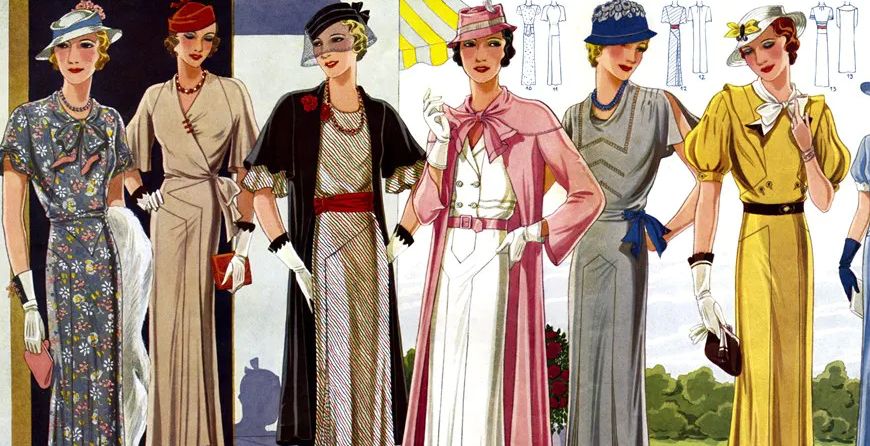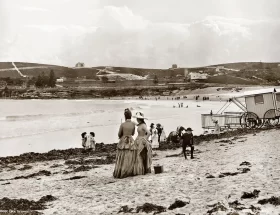In the 1930s there was a return to a more genteel, ladylike appearance. Budding rounded busts and waistline curves were seen and hair became softer and prettier as hair perms improved.
Foreheads that had been hidden by cloche hats were revealed and adorned with small plate-shaped hats. Clothes were feminine, sweet, and tidy by day with a return to real glamour at night. Right – Fashionable sleek day dress of 1936. - The Female Form Returns to 1930s Fashion
Daywear Versus Evening Glamour
Until the 1930s wealthy women had not really needed to wear practical day clothes. Although styles had been designated day styles if they were impractical it had not really mattered as long as maids took care of chores.
Now women had more productive and busier lives and simpler pared-down clothes gave a freedom of movement women relished in daily life.
More luxurious gowns were kept for the evening. New fabrics like metallic lame were very popular at night and were made to shimmer even more richly by adding plastic sequins and glass beads.
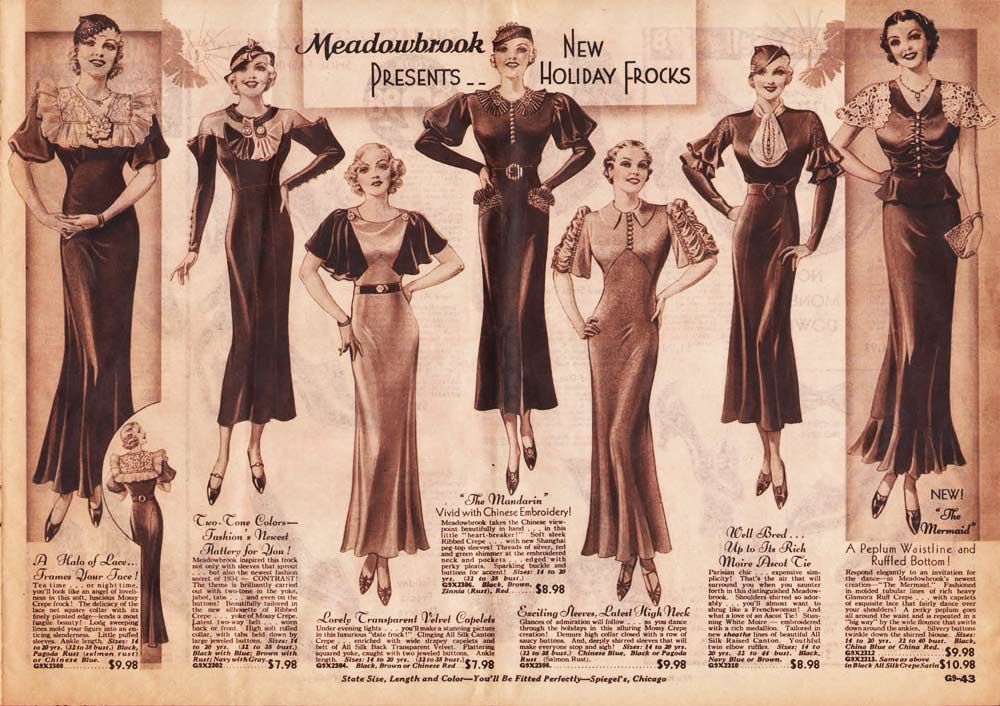
Madeleine Vionnet and the Cross-Cut Bias Method
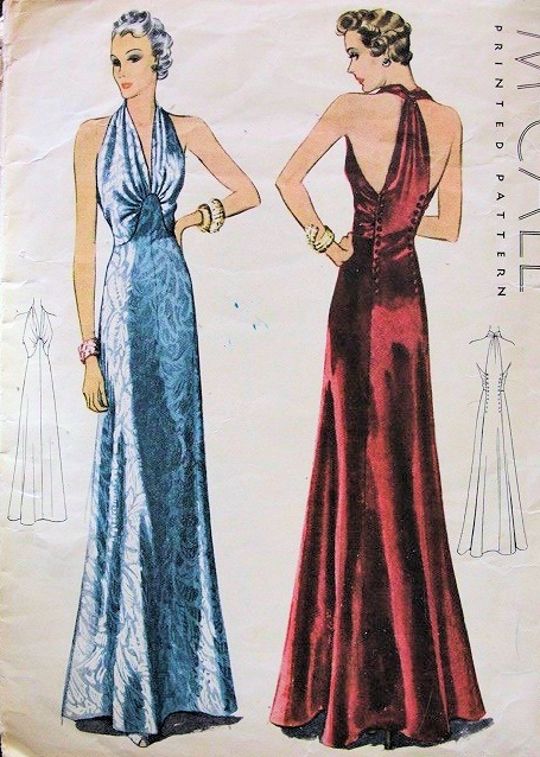
The French designer Madeleine Vionnet opened her own fashion house in 1912. She devised methods of bias cross-cutting during the 1920s using a miniature model. She made popular the halter neck and the cowl neck.
The bias method has often been used to add a flirtatious and elegant quality to clothes.
To make a piece of fabric hang and drape in sinuous folds and stretch over the round contours of the body, fabric pattern pieces can be cut not on the straight grain, but at an angle of 45 degrees.
It is sometimes said that Vionnet invented bias cutting, but historical evidence suggests that close-fitting gowns and veils of the medieval period were made with cross cut fabrics.
The Edwardians also made skirts that swayed to the back by joining a bias edge to a straight grain edge and the result was a pull to the back that formed the trained skirt. She did really popularise it and the resulting clothes are styles we forever associate with movie goddesses and dancers like Ginger Rogers.
Using her technique designers were able to produce magnificent gowns in satins, crepe-de-chines, silks, crepes and chiffons by cross cutting the fabric, creating a flare and fluidity of drapery that other methods could not achieve.
Many of the gowns could be slipped over the head and came alive when put on the human form. Some evening garments made women look like Grecian goddesses whilst others made them look like half-naked sexy vamps. Certain of her gowns still look quite contemporary.
There was a passion for sunbathing. Women tried to get tans and then show them off under full-length backless evening dresses cut on the true cross or bias and which moulded to the body.
To show off the styles a slim figure was essential and that was getting easier for women who were educated and aware as many now used contraception and did not have to bear baby after baby unless desired.
1930s Fashion – Skirts
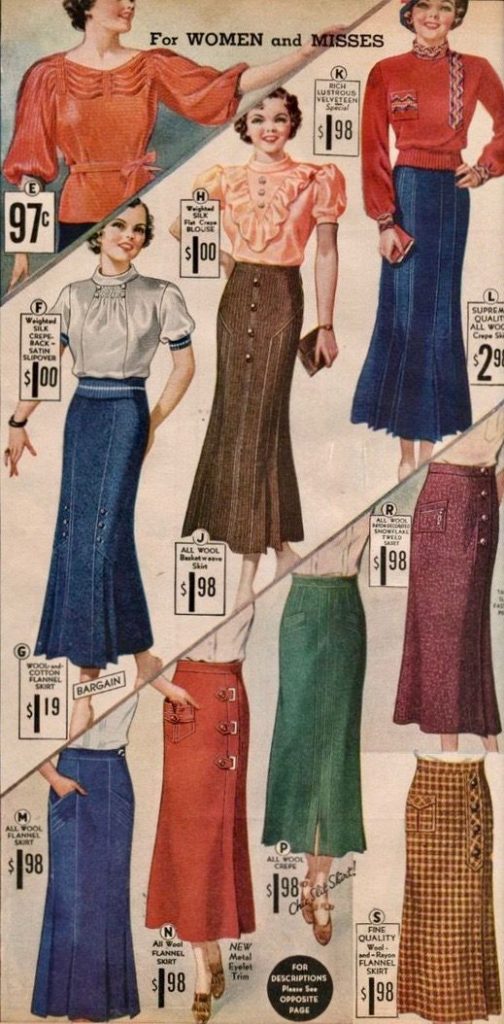
Skirts were frequently longer at the back than the front. Pleats and godets were inset into panels from below the knee and these insets gave more fullness at the hemline. The hemlines reached the bottom of the calf within a year.
Some of the clothes were so stylish that they could be worn today. Part of their appeal was the draping fabric that was further enhanced by cutting fabrics on the true cross or the bias grain also quite fashionable at the start of the new millennium.
You are reading an original ‘1930s – Stylish Thirties’ fashion history article by Pauline Weston Thomas at www.fashion-era.com ©
New Ways With Fabrics – 1930s Fashion
The new improved fabrics like rayon had several finishes and gave various effects exploited by designers eager to work with new materials. Cotton was also used by Chanel and suddenly it was considered more than a cheap fabric for work clothes.
But nothing cut and looked like pure silk and it was still the best fabric to capture the folds and drapes of thirties couture. Fine wool crepes also moulded to the body and fell into beautiful godets and pleats.
The new improved fabrics like rayon had several finishes and gave various effects exploited by designers eager to work with new materials.
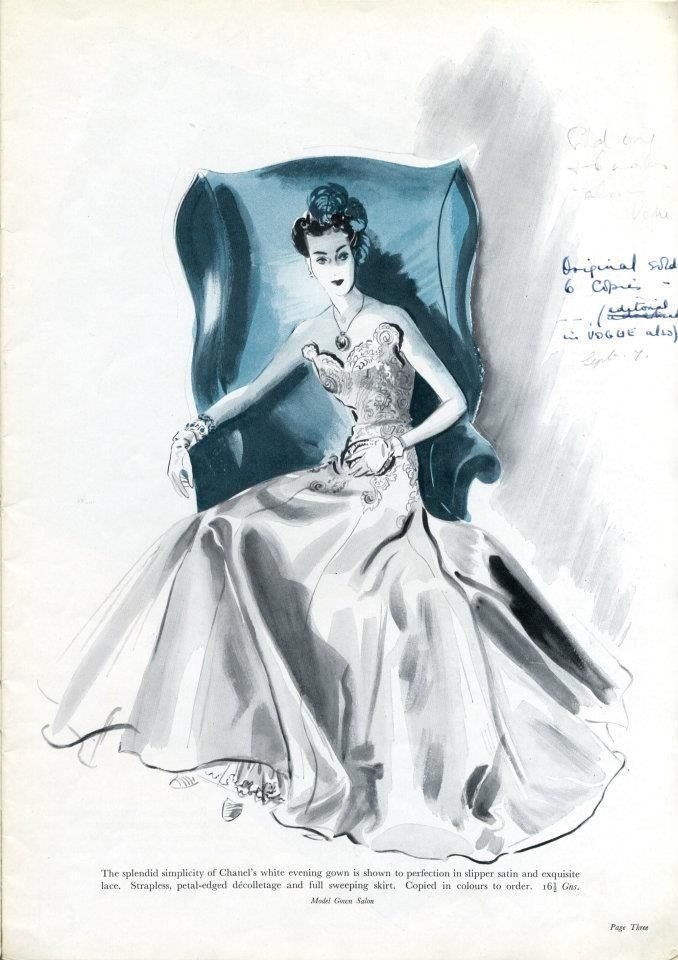
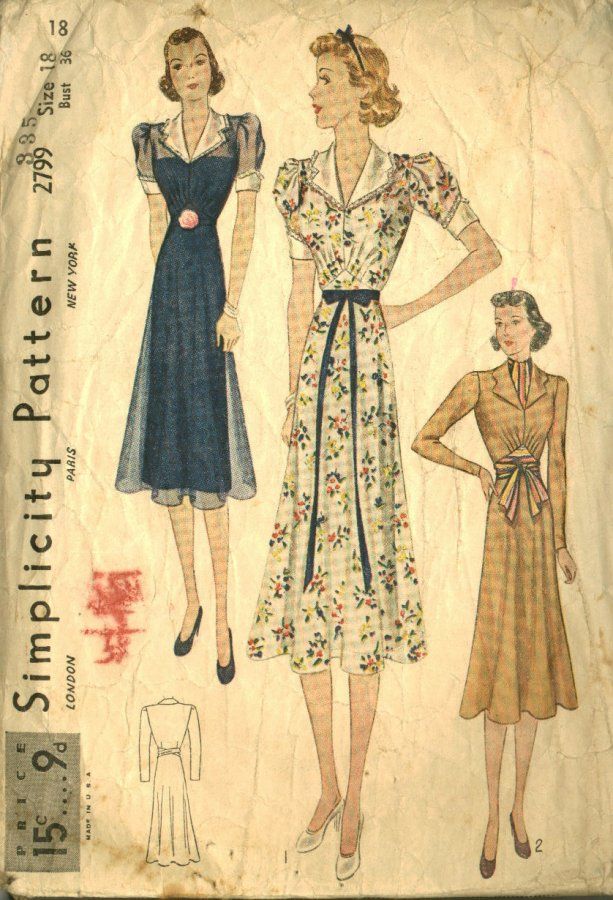
Cotton was also used by Chanel and suddenly it was considered more than a cheap fabric for work clothes.
But nothing cut and looked like pure silk and it was still the best fabric to capture the folds and drapes of thirties couture. Fine wool crepes also moulded to the body and fell into beautiful godets and pleats.
Rayon dyed well and looked similar to and felt like silk. Often it was used to make lingerie for the cheaper end of the market.
Wallace Carothers Invents Nylon 1927, Production 1938
In 1927 Dr. Wallace Carothers began to research new polymers and eventually discovered polyamide. By 1938 the Du Pont company was producing commercial nylon and by 1939 making knitted hosiery. Later it was given the commercial name Nylon.
Nylons were eventually available in 15 deniers and these were very sought after particularly in the 2nd World War.
Nylon hosiery transformed women's lives. No more bagging and sagging of stockings and a sheer allure that enhanced their legs. The women of the era must have felt much the same as women of the sixties did later when tights gave a new freedom.
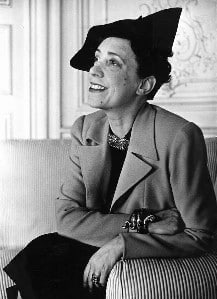
The Italian Elsa Schiaparelli 1890-1973 had a love of rich fabrics and feminine fantasy clothes that frequently had a surreal twist.
She mixed with the now famous cubist and surrealist artists Man Ray, Salvador Dali, Marcel Duchamp and Francis Picabia.
Fabric and accessories were often designed for her by Dali, Jean Cocteau, and Christian Berard. She began her early career with Trompe l’Oeil effects and a famous navy sweater with a contrast cream neckline and cream bow knitted into the design.
Despite the fact that Schiaparelli had a witty side she was just the fashion inspiration that women who preferred classic styles needed.
Those that loathed the swathes of pastel chiffon produced by Vionnet were easily compensated by ‘Scap’s’ couture short fitted suits or jackets teamed with black dresses. She used colours like turquoise or shocking pink or hyacinth blue.
Beyond the little black dress which she frequently designed, she would accessorise with humour and designed funky hats made to appear as mutton chops or ice cream cones. Her eccentricity was much loved and her clothes were revolutionary at the time.
She designed a wide shouldered masculine suit that Marlene Dietrich wore and which was copied throughout Hollywood. She launched shoulder pads in man tailored severe suits long before power dressing of the 80s.
It was her late 1930s tailored suit designs which were thought the most suitable clothing to embrace in the war years rather than the wasp waist bouffant dresses that were shown just before the war started.
Schiaparelli and Chanel were great rivals who both vied for top designer fame and competed hotly against each other over their perfumes. Schiaparelli’s Shocking perfume in an hour glass bottle designed on Mae West’s figure was fiercely competitive against Chanel’s perfume Chanel No 5.
Schiaparelli fled to the USA at outbreak of World War Two and never regained her designer dominance again. She continued to lecture on fashion throughout the war years in America. She held her final fashion show in 1954.
The Zip
Schiaparelli liked new things as well as new ideas. In 1933 she promoted the fastener we call the zip or zipper. The metal zip had been invented in 1893 and by 1917 it was somewhat timidly used for shoes, tobacco pouches and U.S. Navy windcheater jackets.
Her use of the new plastic coloured zip in fashion clothes was both decorative, functional and highly novel. They soon became universally used and are now a very reliable form of fastening.
The 1936 Edward VIII Abdication and Wallis Simpson the Duchess of Windsor
In 1936 Edward VIII abdicated his right to the throne to marry Mrs. Wallis Simpson. On marriage, she became the Duchess of Windsor, but was never ever granted the title H. R. H. However they self-styled themselves as Royal Highnesses and the Duke bought her vast quantities of jewellery.
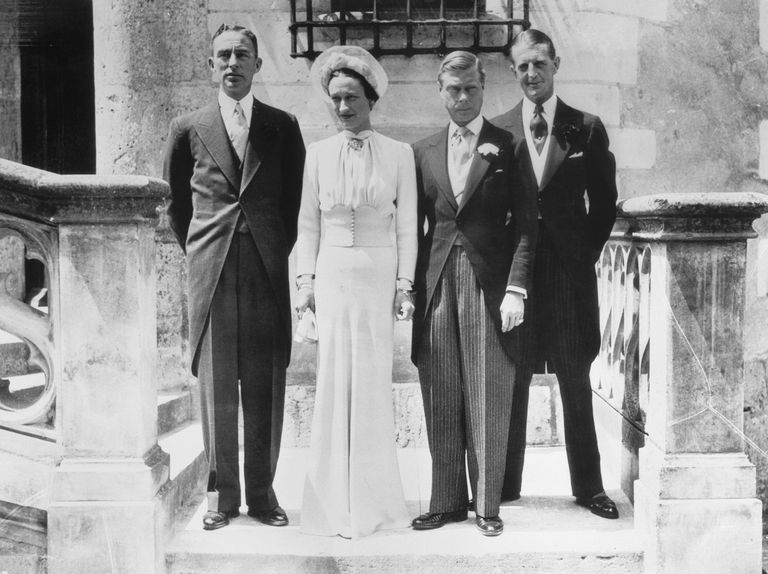
The wedding day of the Duke and Duchess of Windsor.
Her dress was designed by Mainbocher as was the rest of her trousseau.
At the jewellery auction after her death, the pieces were evidence of great style. She continued to wear designer garments by Mainbocher and other famous designers. She was thought an icon of style in her younger days. She is also famed for saying ‘a woman can never be too rich or too thin’.
Unusual Male Fashion of the 1930s
Edward VIII was also a fashion leader in his own right. Here we have a photo of Edward VIII wearing plus fours…. And another of Evan my relative following a very similar fashion.

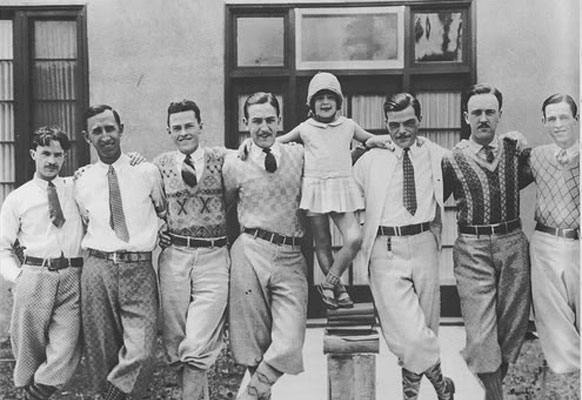
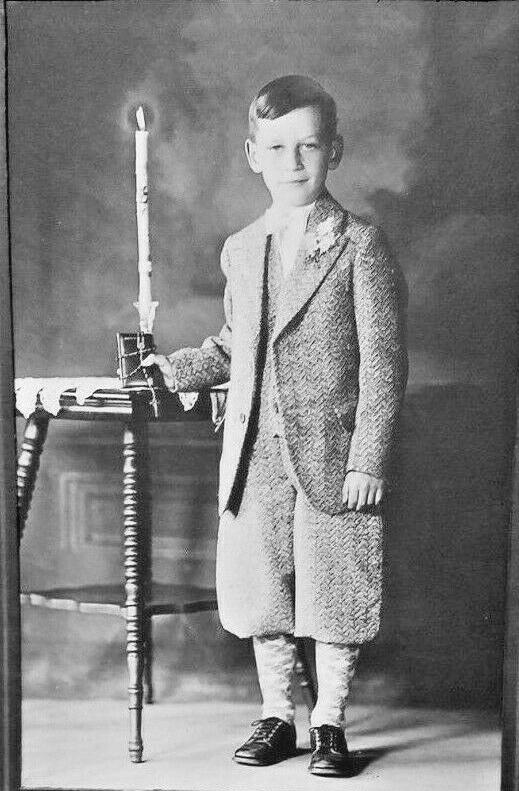
Beach Fashion 1930s
Health and fitness was an important aspect of thirties lifestyle. As sun worshipping became a common leisure pursuit fashion answered the needs of sun seekers by making chic outfits for the beach and its surrounds. Beach wraps, hold alls, soft hats and knitted bathing suits were all given the designer touch.
Swimwear was getting briefer and the back was scooped out so that women could develop tanned backs to show off at night in the backless and low-backed dresses. The colours of the beach holiday were navy, white, cream, grey, black and buff with touches of red.
Pyjamas introduced as informal dinner dress or nightwear for sleeping died quickly as fashions. However, the third use of them as a practical beach outfit caught on and every woman made them an essential garment to pack.
They were soon regarded as correct seaside wear. The trousers were sailor style, widely flared and flat fronted with buttons.
They were made up in draping heavy crepe-de-chine. Blue and white tops or short jackets finished the holiday look. These are illustrated in Sportswear Before 1960.
You are reading an original ‘1930s – Stylish Thirties’ fashion history article by Pauline Weston Thomas at www.fashion-era.com ©
Women’s League of Health and Beauty
In 1930 Prunella Stack started the Women’s League Of Health And Beauty in Britain. The motto was ‘Movement Is Life’ and the League promoted the idea of a healthy mind and a healthy body. The League had thousands of members who put on huge displays in parks and other venues.
Physical fitness was seen as important in the stylish thirties and in various forms was popular across Europe, especially in Germany and Austria.
This resulted in some Tyrolean styles creeping into sportswear fashion which began to be more practical and actually allowed for movement. Skating skirts became shorter than ever before and in 1933 the Tennis star Alice Marble wore shorts at the Wimbledon season.
The Rumble of War
The era had begun with an economic depression which had lifted by 1936 for many. At the same time, the rumble of warmongering in Europe became more evident. Designers began to adjust the mood of their collections to more military-inspired square-shouldered clothing teamed with low heels as if sensing a need for more functional wear. By the time war arrived in 1939 European designers had shown simple clothes, trousers and sweaters and classic shirt waisters designed to stay in fashion.
One interesting facet to fashion was the brief emergence of a wasp waist in the 1939 Paris collections. Both Chanel and Mainbocher played with a full skirt and a waist, but the escapist fashion was not to be. It would be 1947 before Dior introduced his wasp-waist Corolle collection that got dubbed the New Look.
This was a pivotal time for the fashion industry and lessons learnt developing methods of mass-producing uniforms carried over into the ready-to-wear industry.
In the future, it will enable manufacturers to produce quality goods speedily, moderately priced, and within acceptable profit margins.
You have been reading an original ‘1930s – Stylish Thirties’ fashion history article by Pauline Weston Thomas at www.fashion-era.com ©
This post contains affiliate links, so we may earn a small commission when you make a purchase through links on our site at no additional cost to you.
